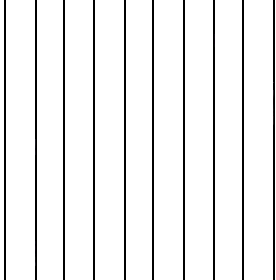
STRAIGHT-LINE SYSTEMS (SUPERIMPOSE, CUT, FOLD)
In these experiments from simple straight
lines to rapidly complicating interrupted lines, curved lines, to superposition of curved
lines (convex and concave) various types of field are suggested. Sometimes they are a mere
manifold of lines, suggesting only a two-dimensional plane, but in other cases they
suggest depth and the coherence of a field implying some sort of active forces within it:
perhaps even non-Euclidean tensions. As presented here these systems serve both as a
programme for the artist and for the viewer, training them in discrimination to perceive
more dimensions.
"In all these experiments, linear systems that deform apparent space (such as
"perspective) are carried out to cover a sheet completely. Commencing with straight
lines, which give an effect of convexity, they are continued with curved convergence. We
have exploited some 200 such fields. It is noted that in the presence of such systems, the
eye articulates all objects in the space." *
Various combinations of straight lines are considered and their flatness or depth; then
operations which can be performed on systems of straight lines such as cutting and
recombining them or folding as one would fold a Japanese Origami to produce
representational figures or to produce, by random folding, one's own non-representational
figure. The exposition begins with the simplest system of parallel lines: (even this will
be shown to have power within the context of a painting or etching - interrupting or
stabilising).
'Take small sheets completely covered with ruled, straight line systems;'

Fig.1. Vertical parallels.
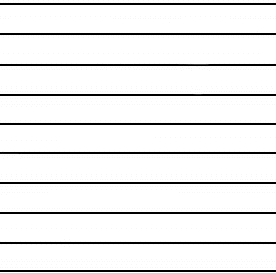
Fig.2. Horizontal parallels
Horizontal lines demonstrate stability.
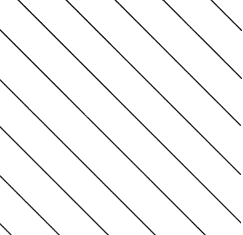
Fig.3. Diagonal parallels
It continues with diagonal lines which have the same properties but also have an intrinsic
perceptible asymmetry which suggests either ascending or descending motion (see section
'Note on Asymmetry').
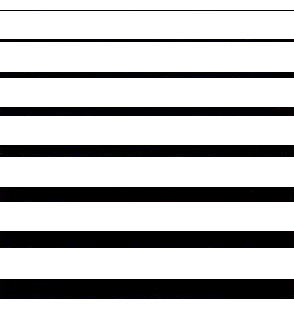
Fig.4. Varying thickness of line
Lines of increasing thickness are shown to create gravity or a concentration of force
around the heaviest.
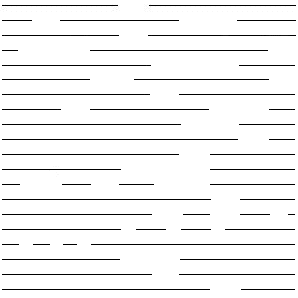
Fig.5. Interrupted lines.
Interrupted lines are considered in their tendency to create a floating space above them
by their very lack of continuity.
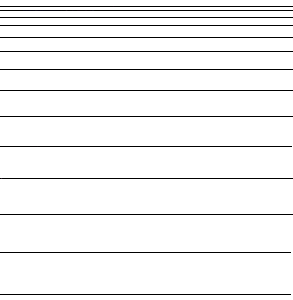
Fig.6. Progressive lines of varied
intervals.
Lines drawn at progressively varied intervals create a different sort of concentration
around their smallest intervals.
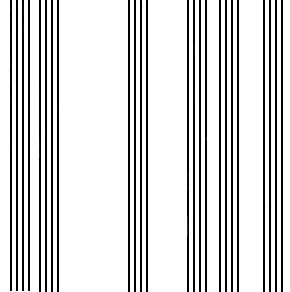
Fig.7. Serial intervals.
Lines distributed at serial intervals create a coherent space (see 'Study of a Swiming
Pool'. from Hayter).
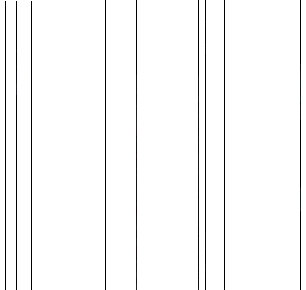
Fig.8. Lines at random intervals.
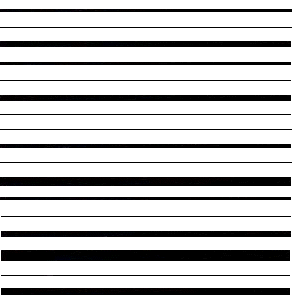
Fig.9. Random thickness of lines with the
same interval.
Lines of random thickness with the same intervals produce a concentration of force about
the thicker.
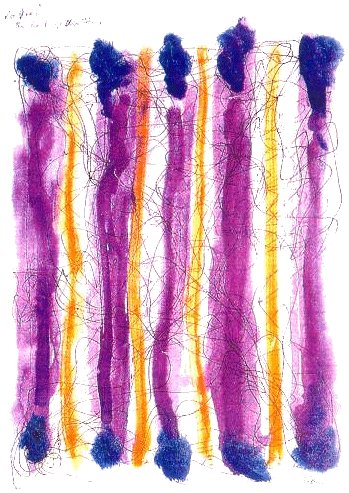
.I. STUDY OF THE SWIMMING POOL, S.W.
Hayter
Watercolor on white board, 1987, 35,9 x 27cm,
'Hayter e l'Atelier 17', Carla Esposito, Electa, p. 94, Milano, 1990
Unconscious drawing with overlying purple and orange
stripes.
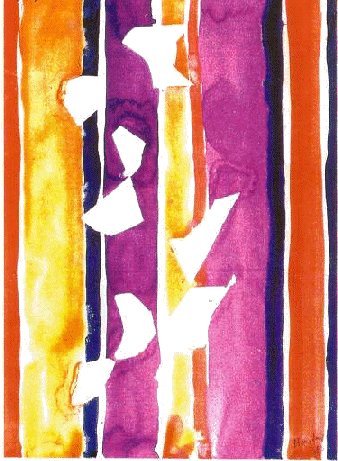
VERTICAL STUDY WITH WHITE SHAPES,
S.W. Hayter
Gouache on white board, 1987, 35,9 x 27cm, 'Hayter
e l'Atelier 17', Carla Esposito, Electa, p. 94, Milano, 1990
Randomly cut out shapes protected from stripes of red,
orange, purple and black.
Superimposing these fairly straight forward
systems of lines, one upon the other, gives rise to a host of possibilities - four of
which are explored here. While the first two do not create three-dimensional space but
rivet the attention on the surface of paper, the following two do have a suggestion of
more dimensional space.
'Superimpose.' This relatively simple operation already gives rise to many possible
results four of which are presented here. They seem, however, to rivet the attention to
the surface of the paper instead of opening up space within it.
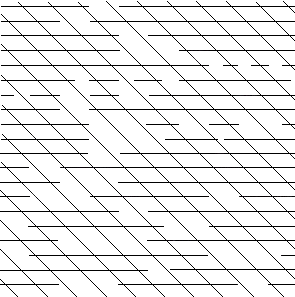
Fig.10. Interrupted broken lines in parallel
superimposed on continuous diagonal lines.
Interrupted broken parallel lines superimposed on diagonals already give an impression of
higher dimensional space - the interrupted lines permitting a negative form to float above
(or behind) and the diagonal lines giving a sense of dynamic direction.
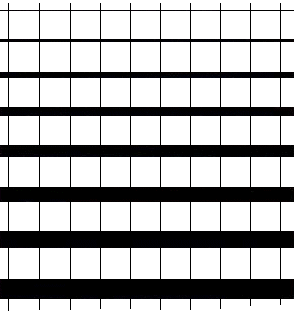
Fig.11. Vertical parallels superimposed on horizontal lines of varying thickness.
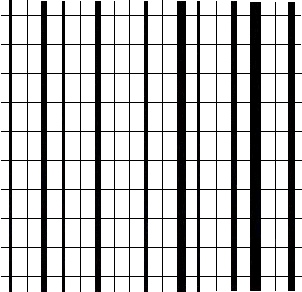
Fig.12. Vertical parallels with randomly
varied thickness superimposed on horizontal parallels.
This grid of horizontal parallels with randomly sized verticals creates an impression of
haphazardly varying vertical forces.
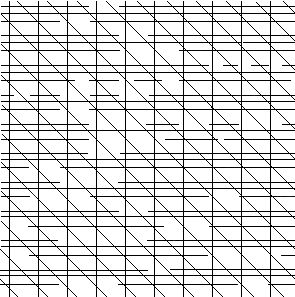
Fig.13. Interrupted broken parallel lines
with continuous diagonal lines and vertical horizontal parallels.
Although this complex drawing forms a grid, through it the interrupted straight lines
leave a certain space floating above or below, the diagonal lines hint a direction. This
drawing remains somewhat labile, the eyes partly grasping the forms suggested above or
below.
'Cut', This one mysterious word refers to the operation of cutting any of the preceding drawings and placing it on or juxtaposed to another drawing, thus giving rise to indefinitely many results, four of which are examined here. These all give rise to ambiguities.
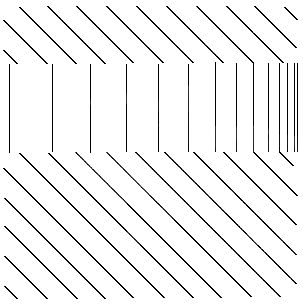
Fig.14. Vertical progressive intervals
against diagonal parallel lines.
This combines the dynamic direction of the diagonal with the compacted vertical
progression.
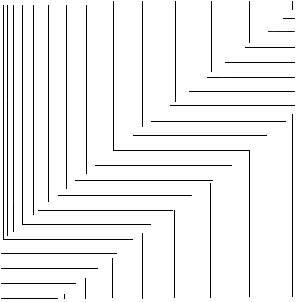
Fig.15. A diagonal section of horizontal
parallels against vertical progressive intervals.
This reads as a pattern in the lower left hand corner but becomes more three-dimensional
as it ascends and the forms connect.

Fig.16. Interrupted broken lines against
horizontal parallel lines.
The diagonal interrupted lines suggest an implied form hovering above or below: therefore
the location of this space remains ambiguous.
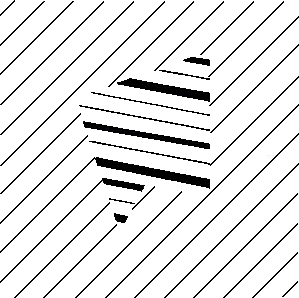
Fig.17. Random thickness of lines against
diagonal parallels.
The ascending diagonals push the lines of varying thickness forward.
Further: cut from three differently lined papers and superimpose them.
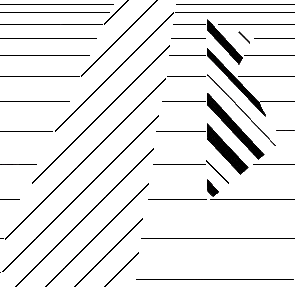
Fig.18. Diagonal parallels and lines of
random thickness against horizontal progressive intervals.
The diagonal parallels seem on a level with the progressive horizontals which push the
random lines forward.
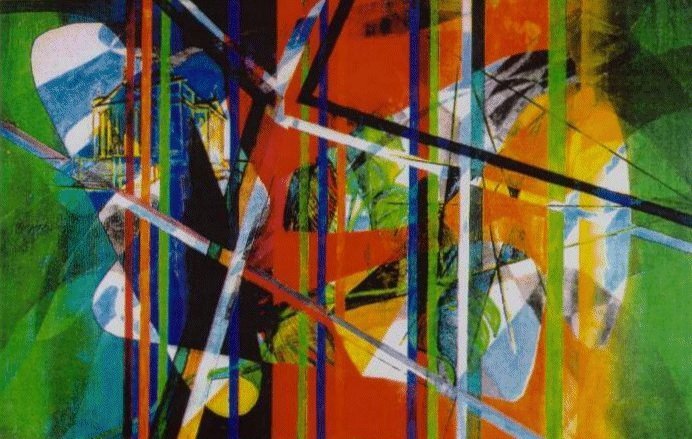
.II. VILLA ROTONDA, S.W. Hayter
Collection of Julian Hayter, Paris.'Hayter e
l'Atelier 17', 117 x 179 cm, 1980, Carla Esposito, Electa, p.78, Milano, 1990
Vertical and diagonal parallels on a complex of curves
partly obliterated, with some figuration in the background.
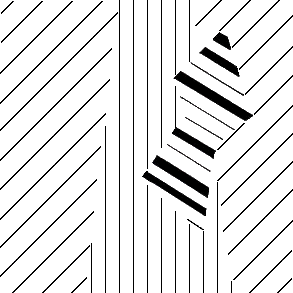
Fig.19. Diagonal lines of random thickness
against vertical parallel lines against diagonal parallels.
The diagonal parallels merge with the vertical parallels which push forward the lines of
varying thickness.
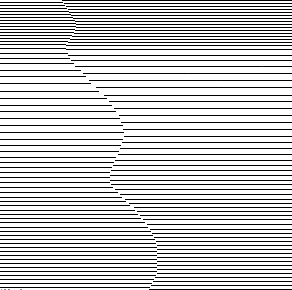
Fig.20. Horizontal parallel lines at
irregular intervals cut at random then slightly displaced downward.
This cutting creates an ambiguity in that the right section seems higher than the left
thus forming a relief.
'Fold'. Create a new shape by folding a lined sheet so that the lines are at an angle to each other. This might be done as in making an origami - a figurative shape which one could not have foreseen from the beginning - otherwise by folding in an independent, abstract way.
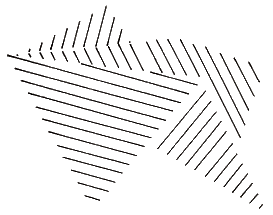
Fig.21.a. Abstract structure folded at random.
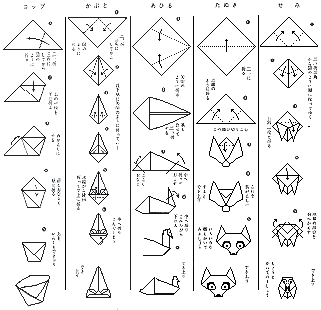
Fig.21.b. Example of Japanese folding entitled "Origami".
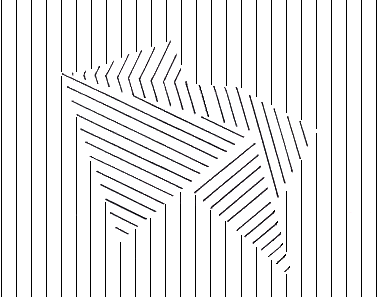
Fig.22. Abstract structure folded at random against vertical parallel lines.
Alternatively they can be opened out into the third dimension slightly to disclose their
varying lines, bent upon themselves.

Photo n°.1. Abstract structure folded at random slightly opened.
*'New ways of Gravure', S.W. Hayter, New-York, 1981, Watson-Guptill Publications, 'les méthodes d'Enseignement à l'Atelier 17'.